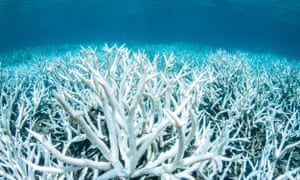The cooling effect of Cyclone Debbie will not be enough to prevent further mass bleaching of the Great Barrier Reef, a leading marine scientist has said.
The category-four tropical storm made landfall on the north Queensland coast on Tuesday, leaving a trail of destruction in its wake. Airlie Beach, Proserpine and Bowen were among the worst hit, though Hamilton, Hayman and Daydream islands were also affected.
The extent of the devastation wrought by the slow-moving cyclone on the embattled reef remains to be seen but suggestions that the wild weather could prevent further mass bleaching have been downplayed.
The environmental charity OceanWatch had expressed hope that the cooling effect of Cyclone Debbie on ocean temperatures could have alleviated the pressure the reef is under and prevented further bleaching.
Temperatures of between 23C and 29C are optimum for coral but the Great Barrier Reef has suffered through unusually warm waters in 2017 and much of 2016, prompting sustained, and in some cases, severe bleaching.
OceanWatch suggested that the wild weather would have brought deeper,
cooler water to the surface while shading the coral from the sun,
reducing light stress.
But Prof Terry Hughes, the director of the Australian Research Council Centre of Excellence for Coral Reef Studies, told Guardian Australia that the effects of Cyclone Debbie would not prevent further mass bleaching events, as the most severe damage this year had occurred north of her path.
“Cyclone Debbie has come a month too late and in the wrong place to prevent mass bleaching,” he said.
The centre began reef-wide aerial surveys on 16 March, though further activities were delayed by Debbie.
Preliminary information from the first survey showed that all reefs assessed between Cairns and Lockhart river showed some signs of bleaching, ranging from mild to severe.
Last week Hughes had flown over the reefs between Mackay and Townsville, which he said were “only very lightly bleached compared to reefs further north”.
“The cloud and wind has cooled down the sea temperature, which might help the lightly bleached corals near the cyclone recover their colour more quickly. But it’s too late for further north.”
The storm had also likely caused structural damage to some coral that, already weakened by bleaching, may struggle to recover.
Earlier this month, the Great Barrier Reef Marine Park Authority confirmed “moderate to severe” mass coral bleaching for the second consecutive year.
The Tasmanian Greens senator Peter Whish-Wilson raised the devastating impact of the bleaching in the Senate on Wednesday.
He quoted Hughes’s tweet last year: “I showed the results of aerial surveys of bleaching on the Great Barrier Reef, and then we wept.”
This drew a mocking response from the Liberals, with the South
Australian senator Simon Birmingham replying that “Senator Whish-Wilson
needs a lot more than a hanky ... [he] needs a reality check”.
The category-four tropical storm made landfall on the north Queensland coast on Tuesday, leaving a trail of destruction in its wake. Airlie Beach, Proserpine and Bowen were among the worst hit, though Hamilton, Hayman and Daydream islands were also affected.
The extent of the devastation wrought by the slow-moving cyclone on the embattled reef remains to be seen but suggestions that the wild weather could prevent further mass bleaching have been downplayed.
The environmental charity OceanWatch had expressed hope that the cooling effect of Cyclone Debbie on ocean temperatures could have alleviated the pressure the reef is under and prevented further bleaching.
Temperatures of between 23C and 29C are optimum for coral but the Great Barrier Reef has suffered through unusually warm waters in 2017 and much of 2016, prompting sustained, and in some cases, severe bleaching.
But Prof Terry Hughes, the director of the Australian Research Council Centre of Excellence for Coral Reef Studies, told Guardian Australia that the effects of Cyclone Debbie would not prevent further mass bleaching events, as the most severe damage this year had occurred north of her path.
“Cyclone Debbie has come a month too late and in the wrong place to prevent mass bleaching,” he said.
The centre began reef-wide aerial surveys on 16 March, though further activities were delayed by Debbie.
Preliminary information from the first survey showed that all reefs assessed between Cairns and Lockhart river showed some signs of bleaching, ranging from mild to severe.
Last week Hughes had flown over the reefs between Mackay and Townsville, which he said were “only very lightly bleached compared to reefs further north”.
“The cloud and wind has cooled down the sea temperature, which might help the lightly bleached corals near the cyclone recover their colour more quickly. But it’s too late for further north.”
The storm had also likely caused structural damage to some coral that, already weakened by bleaching, may struggle to recover.
Earlier this month, the Great Barrier Reef Marine Park Authority confirmed “moderate to severe” mass coral bleaching for the second consecutive year.
The Tasmanian Greens senator Peter Whish-Wilson raised the devastating impact of the bleaching in the Senate on Wednesday.
He quoted Hughes’s tweet last year: “I showed the results of aerial surveys of bleaching on the Great Barrier Reef, and then we wept.”
I showed the results of aerial surveys of #bleaching on the #GreatBarrierReef to my students, And then we wept.
I quoted @profterryhughes saying "I showed the results of bleaching on the reef to my students & then we wept". Watch the govt response.



No comments:
Post a Comment